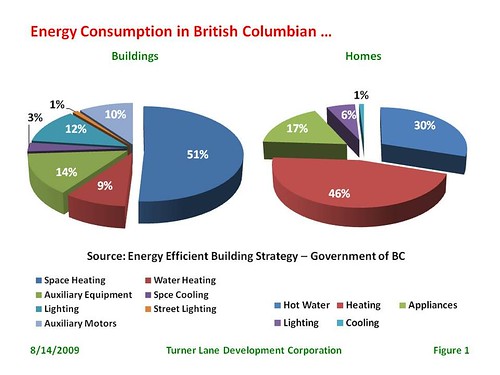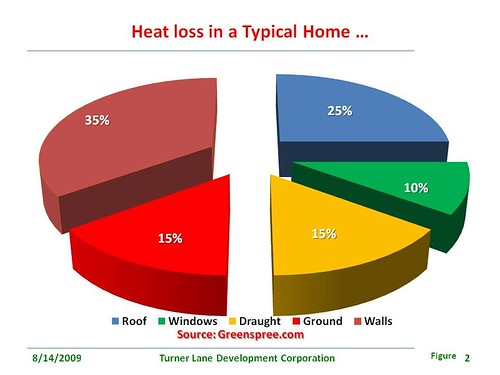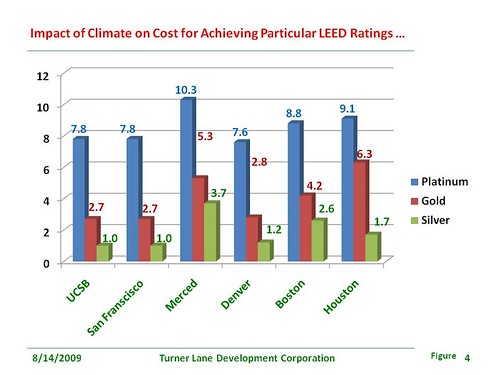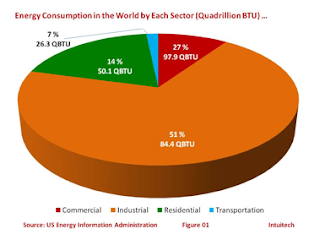The Cost of Building Green
Dr. Mir F. Ali
Commercial real estate executives are increasingly seeking greener office space — and are less inclined to pay premiums for it, according to a recent survey by CoreNet Global and Jones Lang LaSalle. “They are less willing to pay a premium for sustainable space because they understand that it doesn’t cost the owner more to make that space efficient,” said JLL Senior Vice President Michael Jordan.
It’s nothing but a pure misconception on part of commercial real estate executives. There is a cost associated with building green - you better believe it.
It’s true that green buildings are designed to reduce the overall impact of the built environment on human health and the natural environment by:
- Efficiently using energy, water, and other resources;
- Protecting occupant health and improving employee productivity; and
- Reducing waste, pollution and environmental degradation.
However, these wonderful characteristics of a green building come with a price tag which is shared directly or indirectly, willingly or unwillingly by the real estate developers, builders, owners, and tenants. It’s also true that most of the additional or green cost is recoverable through low Life Cycle Operating Costs, low Insurance Rates, Churn Rates, higher Productivity Gains, higher Property Values, and Absorption Rates. Typically, the green cost recovery and potential economic gains for the investments take years depending upon the size of the investments and unfortunately, the commercial real estate executives don’t seem to understand this part of the equation.
There is a huge difference between green and conventional buildings. It takes less energy, electricity, and water for constructing and maintaining green buildings whereas conventional buildings consume natural resources at an alarming rate, accounting for a significant percentage of the world’s energy, electricity, and water consumption. More specifically, the construction of conventional buildings accounts for: 40% of the world’s energy; 25% of the timber harvested; 16% of the fresh water used; 50% ozone depleting CFC’s; 30% of raw materials; and 40% landfill waste.
The following graph (Figure 1) illustrates the consumption of energy in buildings and homes which is based on the Energy Efficient Building Strategy: More Action, Less Energy:

Green Building:
Green building design takes an environmentally sensitive approach to construction and it is a structure that is designed, built, renovated, operated, or reused in an ecological and resource-efficient manner. Project goals, objectives, and results differ from project to project as they are driven by the owner and project team, and there is no formal evaluation process.
Smart developers, designers, and architects who are interested in building green buildings, but whom have no patience for the process to get their buildings certified, can stil build green structures regardless of official certification processes. A primary element in green building is the recognition of the impact of energy efficiency in green buildings.These developers can take advantage of passive design to make sure that the building envelop is air tight, realizing the fact that conventional buildings lose heat (See Figure 2) which has a direct negative impact on the ongoing operational cost. The graph presented below is based on the website, greenspree:

These developers typically incorporate the following passive design features in their building designs:
- Orientation to the sun to provide natural heating and daylighting;
- Building shape - compact building plans have less external wall area and therefore less potential heat loss while long, thin buildings are better for daylighting and cross-flow passive ventilation;
- Harnessing of natural breezes for ventilation - to cool internal spaces and remove contaminants;
- Zoning of rooms and occupant activities to take account of the sun’s movement, daylighting and potential sources of noise;
Using the thermal mass available in the building’s structure - for example in the concrete floor slab - to moderate temperatures and provide heating; - Using correctly sized roof overhangs and other forms of shading to cut out unwanted light and heat;
- Carefully considered placement and sizes of windows and opening sashes;
- Good thermal insulation; and
Choice of materials.
As a part of the process they also use the following key components which make a home an ENERGY STAR Home:
- Sealed Duck System;
- High Performance Heating & Cooling Systems;
- Efficient Appliances & Lighting;
- Better Insulation Windows & Doors; and
- Performance Testing & Quality Assurance.
In addition to making building energy efficient, funds have to be invested in the tools and techniques to minimize waste, reduce greenhouse gas emissions, and generate energy by using renewable technologies which is indeed a significant chunk of cost for building green.
The reality is that Green building design offers similar benefits to certification - less of an environmental impact, healthier and happier employees etc. It also offers some additional benefits:
- No additional time required. With no formal process to adhere to, the project won’t be held up by red tape; and
- Certification-like results without the additional cost.
However, while the big benefit of being green, but not certified, is skipping the arduous, costly process, that benefit is also a downfall. Lack of official verification of the project against a universally recognized standard can be problematic.
Nevertheless, building green even without getting certified is significantly more expensive in comparison with the cost of building conventional buildings.
Certified Green Building:
The most common certification program is the Leadership in Energy and Environment Design (LEED) Green Building Rating System. LEED is a third-party certification program and an internationally accepted benchmark for the design, construction and operation of high performance green buildings. It provides building owners and operators the tools they need to have an immediate and measurable impact on their buildings’ performance.
LEED promotes a whole-building approach to sustainability. Credits and Prerequisites are organized into the following six categories: Sustainable Site Development; Water Efficiency; Energy Efficiency; Materials Selection; Indoor Environmental Quality; and Innovation & Design Process. LEED encourages and accelerates global adoption of sustainable green building and development practices through the creation and implementation of universally understood and accepted tools and performance criteria.
Certification is based on the total point score achieved, following an independent review and an audit of selected Credits. With four possible levels of certification (certified, silver, gold and platinum), LEED® is flexible enough to accommodate a wide range of green building strategies that best fit the constraints and goals of particular projects.
LEED is a recognized standard for the construction industry to assess the environmental sustainability of building designs: A framework for integrated design; A point based rating system; 6 topic areas; 34 credits and maximum of 69 (70 for Canada) points; and 4 performance ratings.
A rapidly-growing number of private sector organizations and governments are adopting LEED certification in their policies, programming and operations, with the goal of achieving and demonstrating sustainability. The reasons for certifying include: Gain recognition for green building efforts; Validate achievement through third party review; Qualify for a growing array of government incentives; and Contribute to a growing green building knowledge base.
The following graph (figure 3) illustrates the incremental construction cost which is based on the document, Compliance with ASHRAE 90.1 and LEED, published by ASHRAE Vancouver Island Chapter:

It can also be noticed that the cost of building small green buildings in comparison with large buildings is significantly higher in all four cases.
What is interesting is that the difference in costs is minimized in case of higher levels of certification. For instance: Costs of small buildings are higher than large buildings by 300 percent, 233 percent, 200 [percent, and 168 percent respectively for the certified, silver, gold, and platinum categories or levels.
Another interesting observation to make is that the cost of constructing LEED certified green buildings differs from climate to climate. For instance, the following graph (Figure 4) illustrates the cost differences for building the LEED certified silver, gold, and platinum buildings in six different climates - UCSB, San Francisco, Merced, Denver, Boston, and Houston. This graph is based on a report, Costing Green: A Comprehensive Cost Database and Budgeting Methodology:

There is a need to understand that in addition to significant increase in building green which could be debateable but there is no argument that the certification of the buildings adds up significant cost to the total costs of buildings. According to a report, the following three relevant points are always brought up when discussing the LEED certification:
- Certification can add time to the project: It’s a rigorous process that requires careful, constant management (usually handled by one person who does nothing but that) and you’ll lose a lot of time if you don’t plan properly;
- It can get expensive: In addition to the registration and certification fees, you will also incur significant commissioning fees that typically add 20-30% to your budget; and
- Un-weighted categories can lead to unfair comparisons: One point equals one point in the rating system, so the single point allocated for installing a $400 bike rack is worth as much as the point given for buying 50% of your energy from renewable sources. There’s no comparison between the environmental impacts of those alternatives-yet they both contribute equally to the certification level of a project.
The discussion about the cost of LEED buildings is only one side of the coin and the other side of the coin of course is the benefits associated with building LEED buildings. To this end, the following table will highlight the energy savings for each level of LEED certification along with the utility savings as well as a typical payback for each level of certification which is based on the document, Compliance with ASHRAE 90.1 and LEED, published by ASHRAE Vancouver Island Chapter:
Economics of LEED (Source: Enermodal Engineering) illustrated below:
| LEED Rating | Certified | Silver | Gold | Platinum |
| LEED Points | 26 to 32 | 33 to 38 | 39 to 51 | 52 to 70 |
| Energy Savings | 25 to 35% | 35 to 50% | 50 to 60% | > 60% |
| Annual Utility Savings | $0.75 sft | $1, 80 sft. | $1, 25 sft. | $1.50 sft. |
| Typical Payback | Under 3 Yrs | 3 to 5 Yrs | 5 to 10 Yrs | 10 + Yrs |
Source: Enermodal Engineering
The bottom line is that there is a cost associated with building green. Municipalities around the world are putting immense pressure on real estate developers to meet their ambitious energy efficiency requirements for building green. What they don’t seem to appreciate is that while the building technologies and renewable energies are widely available and accessible on a global basis, unfortunately they are not cost-effective enough to persuade many North American consumers. Ironically, North American consumers may be suffering from a delusion about the green cost. The fact of the matter is that the European real estate developers have been very successful in building and selling green buildings all over the map, partly because the European municipalities have access to green funds which they use to assist green developments in their jurisdictions and partly because an average European consumer is much more passionate about the environment and he or she is not just focusing on the cost/price when they are purchasing in a commercial or residential building, but the other benefits, social and environmental, are a part of the overall consideration.
Another reason for Europe being so ahead of North America in the field of environmental responsibility is that the taxes being collected by European governments in the name of “carbon tax” or carbon related taxes, are being invested into renewable energies which is helping them to make those technologies affordable and deployable. On the contrary, the carbon taxes or the revenue associated with the carbon related activities in North America is being treated as “Revenue Neutral” which means that that money is returned back to their citizens in the shapes of various tax breaks. In other words, the recycling of the carbon tax money is a huge administrative cost to the citizens without helping in any way to deal with environmental issues.
The good news is that those North American real estate developers with a strategic vision are committed to the concept of sustainability. They have been smart enough to recognize the severity of the situation and have accepted the fact that the only way to survive in this harsh market is to bridge the gap between the cost associated with conventional building and with green building. This will empower them to meet the realistic requirements imposed by their municipalities for building green and also meet the pricing expectations of their consumers who are desperately looking for bargains. They also found the best way to accomplish this objective is to tap into the brainpower of those who are capable of conducting the necessary research to capitalizing on the tools, techniques, and technologies in a way which will help bring down the overall cost of building green. It may take a little longer to find the ultimate solution to the challenge at hand, but these developers are moving in the right direction with a positive attitude and there is always a possibility that the research they are investing in may end up finding ways of optimizing cost, not only just to bridge the gap, but also to build green buildings cheaper than conventional buildings.
Dr. Mir F. Ali is a Sustainability Analyst with Turner Lane Development Corporation, a real estate development company with the commitment to build sustainable communities in British Columbia, Canada (mir@turnerlane.com).

Comments
-Jackie @ Nonprofit software
I absolutely agree with this. The concept of green building is a boon to all architects and builders. With the implementation of green building, it becomes easy for the builders to construct a more efficient building. This, in turn, is helping in the protection of the environment as well as well-being of humans.
While probing on the internet, I came across an exquisite website named as thespinnakergroupinc.com that is providing the service of LEED consultant in Florida.